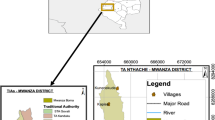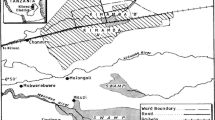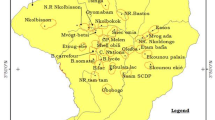Abstract
This study quantified the effect of environmental factors on mosquito larvae control in Okelele community, Ilorin, Kwara state, Nigeria. A community-based, cross-sectional study was conducted using a 3-stage random sampling technique to select Zones, Households and 200 parents/guardians and their children under 14 years of age. Interviews were conducted using a semi-structured questionnaire and key informant interview guide. In addition, water samples from potholes, stagnant water and drainages were collected for mosquito larvae counts using the Bourne method. The mean age of houses was 33.4 ± 11.9 years (Range 1–70) and 58.0 % were built with mud. The mean household population was 6.1 ± 3.1 (Range 1–17), 28.0 % of the respondents (fathers) had no formal education. Most of the houses (99.0 %) had open drainages in their vicinities and 91.9 % were stagnant. Some (65.5 %) of the households had door nets, 17.0 % had mosquito nets, while 13.5 % had Insecticide-Treated Nets (ITN). The environmental problems stated by the respondents were inappropriate solid waste disposal methods, lack of potable water and lack of sanitation facilities. Mean anti-vectors practice score of the respondents was 4.9 ± 2.9 and majority (78.5 %) had poor anti-vector practices. Respondents with primary education (OR 0.28; CI 0.09–0.85), secondary education (OR 0.31; CI 0.10–0.94) and tertiary education (OR 0.28; CI 0.07–0.72) were less likely to have poor anti-vector practices compared to those with no formal education. The mosquito’s larva distribution values per litre in Amuyankan, Omoboriowo, Lowin, Jagun and Babaladifa were 21 ± 6.7, 12 ± 2.9, 25 ± 4.9, 02 ± 1.0 and 17 ± 5.1 respectively. The estimated Larva counts per square metre were 2658 (Amuyankan), 1519 (Omoboriowo), 3165 (Lowin), 253 (Jagun) and 2152 (Babaladifa). Irrespective of the larval count, majority had poor anti-vector practices and this was most common among those with no formal education.
Similar content being viewed by others
References
Baume A, Carol M, Celeste M (2007) Intra-household mosquito net use in Ethiopia, Ghana, Mali, Nigeria, Senegal, and Zambia: are nets being used? Who in the household uses them? Am J Trop Med Hyg 77(5):963–971
Bourne D (2003) Health & management/managing for West Nile virus infection/Technique: collection and counting of mosquito larvae for West Nile virus control. http://wildpro.twycrosszoo.org/S/00Man/WNVOverviews/WNVIndTech/WNVSurveillanceLarvaeCollection.htm. Accessed 10 May 2011
Bugoro H, Jeffery H, Tanya LR, Robert DC, Benny KK, Chan C, Iro’ofa C, Butafa A, Apairamo AB, Cheng-Chen C (2011) Influence of environmental factors on the abundance of Anopheles farauti larvae in large brackish water streams in Northern Guadalcanal, Solomon Islands. Malaria J 10:262
Coker AO, Sridhar MKC (2010) Controlling exposure to biological hazards. ICE manual of health and safety in construction. Institution of Civil Engineers, pp 135–148
Coker AO, Awokola OS, Olomolaiye PO, Booth CA (2008) Challenges of urban housing quality and its associations with neighbourhood environments: insights and experiences of Ibadan City, Nigeria. J Environ Health Res 7(01):21–30
DHS (2008) http://dhsprogram.com/publications/publication-PPT19-Survey-Presentations.cfm.Accessed 10 Jan 2015
Dike N, Onwujekwe O, Ojukwu J, Ikeme A, Uzochukwu B, Shu E (2006) Influence of education and knowledge on perceptions and practices to control malaria in southeast Nigeria. Soc Sci Med 63:103–106
Dye DVT, Rose A, Eric SL, James GK, Jacqueline S, Caroline O (2010) “Before we used to get sick all the time”: perceptions of malaria and use of long-lasting insecticide-treated bed nets (LLINs) in a rural Kenyan community. Malaria J 9:345
Fillinger U, Heleen S, Silas M, Emiel L, Willem T, Steven WL (2009) Identifying the most productive breeding sites for malaria mosquitoes in The Gambia. Malaria J 8:62
Mekonnen Y, Mikutu H, Tedros AG, Karen HW, Asefaw G, Peter B, Steve WL (2005) Can source reduction of mosquito larvae habitat reduce malaria transmission in Tigray Ethiopia? Trop Med Int Health 10(12):1274–1285
Mokuolu O. A, Adedoyin O. T, Ernest S. K, Adesiyun O. O, Adegboye A. O, Abdulkarim A. A, Timi-Oladipo A, Yusuf A, Ojuawo A and Johnson W. B. R (2011) Epidemiology of severe malaria in Ilorin. Proceedings of the 41st Paediatrics Association of Nigerian conference. Nigerian Journal of Paediatrics.38 (1): 35
Najera J. A, Zaim M (2003) Malaria vector control, World Health Organization communicable disease control, prevention and eradication
National Bureau of Statistics, Nigeria (2006) http://www.nigerianstat.gov.ng/sectorstat/sectors/Population%20and%20Vital%20Statistics. Accessed 10 Jan 2014
Ndo C, Benjamin M, Christophe A (2011) Awareness, attitudes and prevention of malaria in the cities of Douala and Yaounde (Cameroon). BioMed Central Ltd
Ng’ang’a NP, Josephat S, Gayathri J, Violet K, Charity K, Lucy K, Ephantus K, John G, Clifford M (2008) Malaria vector control practices in an irrigated rice agro-ecosystem in central Kenya and implications for malaria control. Malaria J 7:146
Olayemi IK, Ande AT (2008) Survivorship of Anopheles gambiae in relationship to malaria transmission in Ilorin, Nigeria. Online J Health Allied Sci 7(3):1
Oluwande PA (1983) Guide to tropical environmental health and engineering. Nigerian Institute of Social and Economic Research, Ibadan
Ouattara FA, Giovanna R, Constant VAE, Jürg U, Marcel T, Mamadou D, Benjamin GK (2011) Malaria knowledge and long-lasting insecticidal net use in rural communities of central Côte d’Ivoire. Malaria J 10:288
Peterson I, Borrell LN, El-Sadr W, Teklehaimanot A (2009) Individual and household level factors associated with malaria incidence in a highland Region of Ethiopia: a multilevel analysis. Am J Trop Med Hyg 80(1):103–111
Sridhar MKC, Coker AO (2009) ‘‘Treatment and disposal of healthcare wastes’’ in: healthcare waste management—a handbook for developing countries. Ibadan University Press, Ibadan, pp 91–117
Sridhar MKC, Wahab WB, Agbola SB, Badiane A (2009) Health care wastes management. Ibadan University Press, Ibadan
Statistical Package for the Social Sciences version 17.0. SPSS, Inc. (2008)
Walker K, Lynch M (2007) Contributions of Anopheles larval control to malaria suppression in tropical Africa: review of achievements and potential. Med Vet Entomol 21:2–21
World Health Organisation (2011) World Malaria Report profile
World Health Organisation (2014) World Malaria Report profile
Worrall E, Fillinger U (2011) Large-scale use of mosquito larval source management for malaria control in Africa: a cost analysis. Malaria J 10:338
Yamamoto S, Louis VR, Sie A, Sauerborn R (2010) Household risk factors for clinical malaria in a semi-urban area of Burkina Faso, a case-control study. Trans R Soc Trop Med Hyg 104(1):61–65
Acknowledgments
The authors wish to acknowledge the contributions of all who participated in this study, the mothers and their children as well as Mogajis (head of community) and Imams (spiritual head).
Author information
Authors and Affiliations
Corresponding author
Rights and permissions
About this article
Cite this article
Mokuolu, O.A., Coker, A.O., Adejumo, M. et al. Quantifying the Effect of Environmental Factors on Mosquito Larvae Control in a Nigerian Community. Expo Health 8, 277–284 (2016). https://doi.org/10.1007/s12403-016-0202-1
Received:
Revised:
Accepted:
Published:
Issue Date:
DOI: https://doi.org/10.1007/s12403-016-0202-1




